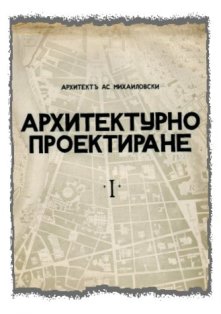
MODERN ARCHITECTURE DESIGN
Author: Asen Mihaylovski
Editor's Note: We wish to relate two more titles from the booklist that already tried to elucidate some historical aspects of Art in this country — viz., "Vasilev, D. History of Early Christian Architecture. Sofia, 1949"; and, "Ivanov, I. Development of Sofia-city Agglomeration ~ Mussman's Plan. Sofia, 1938" (titles speak for themselves), ditto.

Heretofore, we present another occasional publication on the series for art design, stylistic behavior and up-to-date currents at the Bulgarian lands. Staying quite asunder from professional criticism in Humanities as a whole, our aim has been as non-obligatory lancer to express a judgment or opinion without intruding the large massifs and corpuses of information that exist in the field.
In this particular review we deal with a monograph from Arch. Asen Mihaylovski, written and published in the war years of WW II (1943). The author, who was a distinguished Bulgarian architect and designer, couldn't finish the second part of his treatise. He fled away the country in September 1944 with the oversee government of Alexander Tsankov in Vienna, and from there migrated to Brasil where he spent his time until death. We don't have more details on this talented Bulgarian artist but for the sake of argument wish to expose some factology coming straight from the centre of Sofia-city. Captions at several imposing buildings on "Rakovska Street" bear his name (Slavyanska Beseda Hotel, National Opera House, etc.) Since A. Mihaylovski's name was deleted from the city-cadastre we couldn't exactly point out the singular contribution of this distinguished man.
As usually happens, what a belligerent hand or envious eye delete as archival evidence further-in-time the traces of history reveal its unextinguished parables. We found this book as chance purchase in an Antiquary and immediately put it here in the booklist. The monograph in big octavo contains precious information on development of Modernism as style in architecture; simultaneously, given are reminiscences on the whole course of Renaissance period much like Jacob Burckhardts' "Civilization of Renaissance in Italy". The famous book from the Swiss author, written 1860, is only a canvass for this Bulgarian prototype. Mihaylovski makes every effort to write a modern compendium that walks hand-in-hand with contemporary currents of architectural thought. Hence we excerpted a complementary material from circulation sources that illustrates the attitudes of the author:
1) about the space-time dilemma and the "provision for play" (Homo Ludens);
2) about the concept of forums, squares and boulevards as epitomized by King Louis Napoleon III, his adviser Baron Haussmann, and the 2nd French Revolution 1852-1870;
3) about Villa d'Este at Tivoli near Rome and political symbolism of Baroque gardens in XVI century, the apogee of Roman Catholicism;
4) finally about the Modern Arena with Olympic dimensions as created in the patron-states (Italy, Germany, etc.) with Bulgaria as ally to both striving to present a model view for new city-axis of Sofia.
Thus willy-nilly as following the narrative of Mihaylovski we get the general idea of the book. Imminently, we Bulgarians, don't have a Renaissance as "rebirth" of Latin letters and the Fine Arts. Our Revival was mimicry of a kind of awareness that Dark Ages ever existed after the Fall of Rome under the Barbarians. As a logical consequence the Fall of Constantinople to the Turks (1453) became mere postponement of events and characterizations that centuries-in-row later were necessitated to comprehend their essence as growth of World Civilization and holy Origins of Morality.
Copyright © 2011 by the author.